The Lyrid meteor shower is starting
Bruce McClure in ASTRONOMY ESSENTIALS | April 16, 2018
You might see some Lyrids this week. April 22 is the peak morning. Try April 21 and 23 as well. Good news … the moon is out of the way.
The annual Lyrid meteor shower is starting! It’s active each year from about April 16 to 25. In 2018, the peak of this shower – which tends to come in a burst and usually lasts for less than a day – is expected to fall on the morning of April 22, with little or no interference from the waxing moon.
Composite image of Lyrid and not-Lyrid meteors over New Mexico from April, 2012. Image via NASA/ MSFC/ Danielle Moser.
No matter where you are on Earth, expect the greatest number of meteors to fall during the few hours before dawn.
All in all the Lyrid meteor shower prospects look pretty good for 2018, though meteor showers are notorious for being fickle and not totally predictable.
In a moonless sky, you might see from about 10 to 20 Lyrid meteors an hour at the shower’s peak on the morning of April 22. In 2018, the waxing moon will set before the primetime morning hours. Those predicted maxima assume you are watching in a dark, country sky.
Courtesy of NASA/George Varros.
An outburst of Lyrid meteors is always a possibility, too, though no Lyrid outburst is predicted for 2018.
In 1982, American observers did see an outburst of nearly 100 Lyrid meteors per hour. Around 100 meteors per hour were seen in Greece in 1922 and from Japan in 1945.
 |
 |
|
|||||||||||
 |
 |
||||||||||||
|
|
|
|
|
|
|
||||||||
 |
|
|
|
|
|
 |
|||||||
|
|
|
|
|||||||||||
|
|
|||||||||||||
|
|
|
|
|
|
|
|
|
|
|
|
|
|
|
Results 641 to 650 of 679
-
04-18-2018, 12:27 PM #641
Last edited by ilan; 04-18-2018 at 12:31 PM.
Beginner's Guide for Rocket, NFPS and IKS66...
http://iptvtalk.net/showthread.php?2...-you-should-do
Kodi Options for Rocket, NFPS and IKS66...
http://iptvtalk.net/forumdisplay.php?71-Kodi
Check the Announcement Section...
http://iptvtalk.net/forumdisplay.php...-Announcements
-
04-19-2018, 12:33 PM #642Was another civilization on Earth before humans?
Deborah Byrd in EARTH | HUMAN WORLD | April 18, 2018
How do we know earlier industrial civilizations on Earth didn’t rise and fall long before humans appeared? That’s the question posed in a new scientific thought experiment.

Were others here before us? Photo by James Younger at Vancouver Island, B.C.
It’s a compelling thought experiment. What if there were an industrial civilization on Earth before us? What if, over the course of tens of millions of years, all of the direct evidence for it were ground to dust? Would it be possible to detect evidence of this civilization-infused dust in the geologic record? Astrophysicist Adam Frank of the University of Rochester, and Gavin Schmidt, director of the NASA Goddard Institute for Space Studies, tackle this question in a paper published April 10, 2018, in the peer-reviewed International Journal of Astrobiology (view online here).
They call their study the Silurian Hypothesis after a race of intelligent, bipedal reptiles — known as the Silurians — introduced in a 1970 episode of the British science fiction series Doctor Who. Why? It’s because, as Frank explained in an April 2018 article in The Atlantic:
… if we’re going back this far, we’re not talking about human civilizations anymore. Homo sapiens didn’t make their appearance on the planet until just 300,000 years or so ago.
The idea for Frank and Schmidt’s new paper sprang in part from Frank’s studies of global warming from what he called an astrobiological perspective. In other words, he’d been asking whether any industrial civilization that rises on any planet will, through its own activity, trigger its own version of a climate shift. He explained:
We’re used to imagining extinct civilizations in terms of the sunken statues and subterranean ruins. These kinds of artifacts of previous societies are fine if you’re only interested in timescales of a few thousands of years. But once you roll the clock back to tens of millions or hundreds of millions of years, things get more complicated …
Could researchers find clear evidence that an ancient species built a relatively short-lived industrial civilization long before our own? Perhaps, for example, some early mammal rose briefly to civilization building during the Paleocene epoch about 60 million years ago. There are fossils, of course. But the fraction of life that gets fossilized is always minuscule and varies a lot depending on time and habitat. It would be easy, therefore, to miss an industrial civilization that only lasted 100,000 years – which would be 500 times longer than our industrial civilization has made it so far.
As in the well-known Kardashev scale – often invoked in discussions of possible alien civilizations – Frank and Schmidt define a prior earthly civilization by its energy use. A statement from the University of Rochester said:
Human beings are just entering a new geological era that many researchers refer to as the Anthropocene, the period in which human activity strongly influences the climate and environment. In the Anthropocene, fossil fuels have become central to the geological footprint humans will leave behind on Earth. By looking at the Anthropocene’s imprint, Schmidt and Frank … lay out evidence of what might be left behind if industrial civilizations like ours existed millions of years in the past.
Human beings began burning fossil fuels more than 300 years ago, marking the beginnings of industrialization. The researchers note that the emission of fossil fuels into the atmosphere has already changed the carbon cycle in a way that is recorded in carbon isotope records. Other ways human beings might leave behind a geological footprint include:
- Agriculture, through greatly increased erosion and sedimentation rates.
- Plastics, synthetic pollutants, and even things such as steroids, which will be geochemically detectable for millions, and perhaps even billions, of years.
- Nuclear war, if it happened, which would leave behind unusual radioactive isotopes.
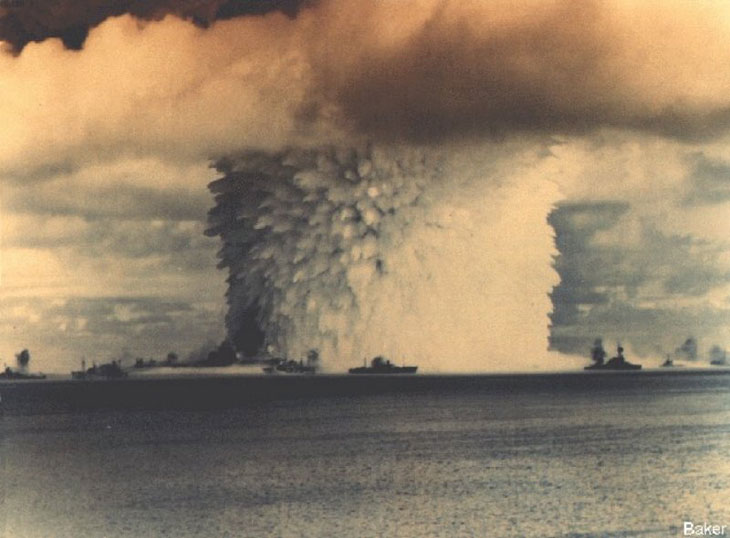 In 2016, 28 of 35 members of an Anthropocene working group for the 35th International Geological Congress agreed that a golden spike in Earth’s sediment layers – an event or group of events laid down in the rocks clearly demarcating one geologic epoch from another – comes around the 1950s. That’s when what’s called the great acceleration began on Earth, when our human impacts intensified and began to happen globally, not just locally. Nuclear tests, like the 1946 test at Bikini Atoll, shown here, are examples of human-caused global events whose traces might be found in the rock record. Image via U.S. Dept. of Energy.
In 2016, 28 of 35 members of an Anthropocene working group for the 35th International Geological Congress agreed that a golden spike in Earth’s sediment layers – an event or group of events laid down in the rocks clearly demarcating one geologic epoch from another – comes around the 1950s. That’s when what’s called the great acceleration began on Earth, when our human impacts intensified and began to happen globally, not just locally. Nuclear tests, like the 1946 test at Bikini Atoll, shown here, are examples of human-caused global events whose traces might be found in the rock record. Image via U.S. Dept. of Energy.
Frank wrote in The Atlantic:
Ironically, however, the most promising marker of humanity’s presence as an advanced civilization is a by-product of one activity that may threaten it most.
When we burn fossil fuels, we’re releasing carbon back into the atmosphere that was once part of living tissues. This ancient carbon is depleted in one of that element’s three naturally occurring varieties, or isotopes. The more fossil fuels we burn, the more the balance of these carbon isotopes shifts. Atmospheric scientists call this shift the Suess effect, and the change in isotopic ratios of carbon due to fossil-fuel use is easy to see over the last century. Increases in temperature also leave isotopic signals. These shifts should be apparent to any future scientist who chemically analyzes exposed layers of rock from our era.
Frank said that looking at the rise and fall of civilizations in terms of their planetary impacts might also affect how researchers approach future explorations of other planets:
We know early Mars and, perhaps, early Venus were more habitable than they are now, and conceivably we will one day drill through the geological sediments there, too. This helps us think about what we should be looking for.
And he said:
By asking about civilizations lost in deep time, we’re also asking about the possibility for universal rules guiding the evolution of all biospheres in all their creative potential, including the emergence of civilizations. Even without pickup-driving Paleocenians, we’re only now learning to see how rich that potential might be.
Bottom line: In a new paper published in April 2018 in the International Journal of Astrobiology, Adam Frank at the University of Rochester and Gavin Schmidt at the NASA Goddard Institute for Space Studies ask what signs an ancient pre-human industrial civilization would have left in the geologic record.Last edited by ilan; 04-19-2018 at 12:49 PM.
Beginner's Guide for Rocket, NFPS and IKS66...
http://iptvtalk.net/showthread.php?2...-you-should-do
Kodi Options for Rocket, NFPS and IKS66...
http://iptvtalk.net/forumdisplay.php?71-Kodi
Check the Announcement Section...
http://iptvtalk.net/forumdisplay.php...-Announcements
-
04-20-2018, 12:43 PM #643April 21 is International Astronomy DayApril 21 will be 2018’s International Astronomy Day. The chart above shows the sky you will be able to see if you stay out after darkness falls, maybe with astronomical friends and their telescopes.
Guy Ottewell in ASTRONOMY ESSENTIALS | HUMAN WORLD | April 20, 2018
A beautiful chart from astronomer Guy Ottewell, showing the evening sky on Astronomy Day 2018.

View larger image
Or just go outside and look!
At the time and place of our chart – Astronomy Day evening, April 21, 2018 – Venus is just setting. Though, as always, brighter than any star or other planet, it has climbing and brightening to do before reaching its climax in the evening sky four months from now.
Over in the east, the second brightest planet has risen: Jupiter, which will be at opposition on May 8-9. The other planets will rise later through the night, being on the morning side of the sun.
__________________________________
With the Moon as a reference point, tracking down the objects will be made easier. It would be a great night to "look to the skies!" - ilanLast edited by ilan; 04-20-2018 at 05:56 PM.
Beginner's Guide for Rocket, NFPS and IKS66...
http://iptvtalk.net/showthread.php?2...-you-should-do
Kodi Options for Rocket, NFPS and IKS66...
http://iptvtalk.net/forumdisplay.php?71-Kodi
Check the Announcement Section...
http://iptvtalk.net/forumdisplay.php...-Announcements
-
04-21-2018, 12:31 AM #644
Right Now on Channel 120, History. Is a 4 Hour Special :
Ancient Aliens: Declassified
Otherworldly Destinations
(New, True, 4/20/2018, TV-PG)
Replay at Midnight EST...!
-
04-21-2018, 01:11 AM #645
Sometimes these are pretty good. Sometimes they are slow and dry.
Beginner's Guide for Rocket, NFPS and IKS66...
http://iptvtalk.net/showthread.php?2...-you-should-do
Kodi Options for Rocket, NFPS and IKS66...
http://iptvtalk.net/forumdisplay.php?71-Kodi
Check the Announcement Section...
http://iptvtalk.net/forumdisplay.php...-Announcements
-
04-21-2018, 12:20 PM #646‘Spectacular’ Lagoon Nebula Featured for Hubble’s 28th Anniversary
On the 24th of April, Hubble will celebrate the 28th anniversary of its liftoff on the Space Shuttle. NASA released a Flythrough of the Lagoon Nebula on 19 April commemorating the event using images captured by Hubble. SPACE took that footage and wove it into a 4 minute tribute to Hubble. It is a cool offering and a must watch. - ilan
Last edited by ilan; 04-21-2018 at 09:26 PM.
Beginner's Guide for Rocket, NFPS and IKS66...
http://iptvtalk.net/showthread.php?2...-you-should-do
Kodi Options for Rocket, NFPS and IKS66...
http://iptvtalk.net/forumdisplay.php?71-Kodi
Check the Announcement Section...
http://iptvtalk.net/forumdisplay.php...-Announcements
-
04-21-2018, 03:21 PM #647
-
04-22-2018, 12:43 PM #648How TESS will hunt for alien worlds
EarthSky Voices in HUMAN WORLD | SPACE | April 22, 2018
Launched last week, TESS will scan 200,000 close and bright stars, seeking new planets and possibly livable worlds. Here’s a roundtable discussion with 2 scientists on the TESS mission.
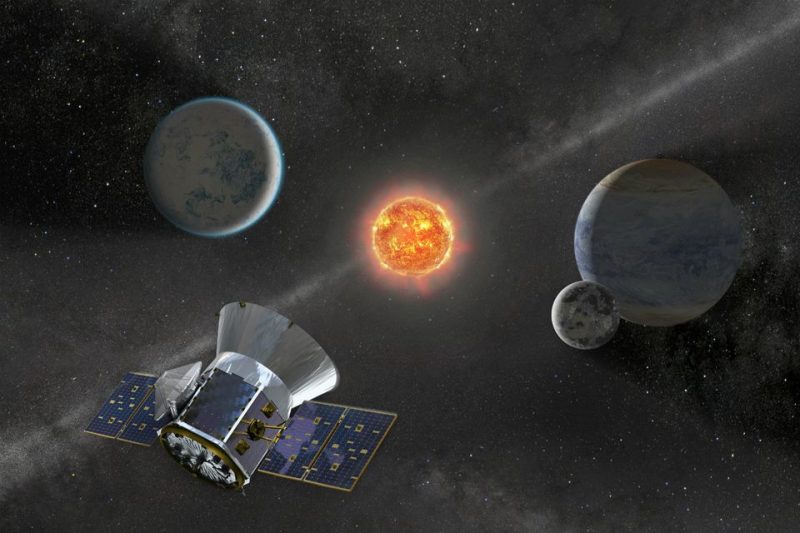
Via The Kavli Foundation
A new era in the search for exoplanets — and the alien life they might host—has begun. Aboard a SpaceX rocket, the Transiting Exoplanet Survey Satellite (TESS) launched on April 18, 2018. Over the next two years, TESS will scan the 200,000 or so nearest and brightest stars to Earth for telltale dimming caused when exoplanets cross their stars’ faces.
The Kavli Foundation spoke with two scientists on the TESS mission, to get an inside look at its development and revolutionary science aim of finding the first “Earth twin” in the universe. The participants were Greg Berthiaume, Instrument Manager for the TESS mission and Diana Dragomir, Hubble Postdoctoral Fellow at the MIT Kavli Institute for Astrophysics and Space Research.
******
The Kavli Foundation: Starting with the big picture, why is TESS important?
Diana Dragomir: TESS is going to find thousands of exoplanets, which might not sound like a big deal, because we already know of nearly 4,000. But most of those discovered planets are too far away for us to do anything more than just know their size and that they are there. The difference is that TESS will be looking for planets around stars very close to us. When stars are closer to us, they’re also brighter from our point of view, and that helps us discover and study the planets around them much more easily.
Greg Berthiaume: One of the things TESS is doing is helping to answer the fundamental question, “Is there other life in the universe?” People have been wondering that for thousands of years. Now TESS won’t answer that question directly, but it’s a step, just like Diana mentioned, on the path to getting us the data to see where there might be other life out there. That’s something we’ve been struggling with and questioning since we were able to come up with questions.
TKF: What exactly do you expect TESS to find?
Dragomir: TESS will probably find 100 to 200 approximately Earth-size worlds, as well as thousands of more exoplanets all the way up to Jupiter in size.
Berthiaume: We’re trying to find planets that are Earth analogs, meaning they’ll be Earth-like in their characteristics, such as size, mass, and so on. That means we want to find planets with atmospheres, with gravity similar to Earth’s. We want to find planets that are cool enough so water can be liquid on their surfaces, and not so cold that the water is frozen all the time. We call these “Goldilocks” planets, located in a star’s “habitable zone.” That’s really our target.
Dragomir: Exactly right. We want to find the first “Earth twin.” TESS will mainly find planets in the habitable zone of red dwarfs. These are stars a bit smaller and cooler than the sun. A planet around a red dwarf can be located in an orbit closer to its star than it could be with a hotter star like our sun and still maintain that nice, Goldilocks temperature. Closer orbits translate to more transits, or star crossings, which makes these red dwarf planets easier to find and study than planets around sun-like stars.
Astronomers are working hard on ways that we might push the TESS data and find some planets in the habitable zone of sun-like stars, too. It’s challenging because those planets have longer orbital periods – years, that is – than close-in planets. That means we need a lot more observation time in order to detect enough transits of the planets across their stars to say we’ve definitely detected a planet. But we’re hopeful, so stay tuned!
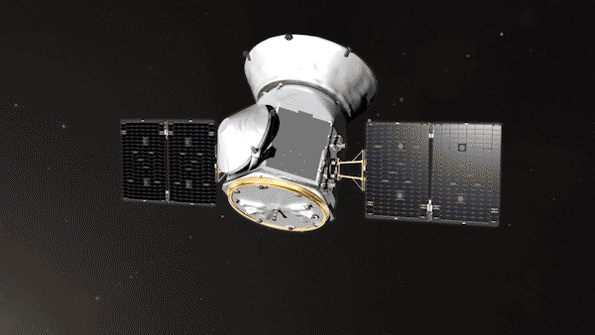
TESS will discover thousands of exoplanets in orbit around the brightest stars in the sky.
TKF: What do you need to see in order to deem any of the planets discovered by TESS as potentially habitable?
Dragomir: We want a planet to be close to Earth in size for all the reasons we just gave, but there’s a small problem with that. Those sorts of planets will probably have pretty small atmospheres, compared to how much rock makes up their bulk. And for most telescopes to be able to look at an atmosphere in detail, we actually need the planet to have a substantial atmosphere.
This is because of a technique we use called transmission spectroscopy. It gathers the light from the star that has gone through the atmosphere of the planet when the planet is crossing the star. That light comes to us with a spectrum of the planet’s atmosphere imprinted on it, which we can analyze to identify the composition of the atmosphere. The more atmosphere there is, the more material there is that can imprint on the spectrum, giving us a bigger signal.
If the light from the star is going through very little atmosphere, though, like we’d be looking at with an Earth twin, the signal would be very small. Based on what TESS finds, we’re therefore going to be starting with bigger planets that have a lot of atmosphere, and as we get better instruments, we’re going to move towards smaller and smaller planets with less atmosphere. It’s those latter planets which will more likely be habitable.
Berthiaume: What we’re going to look for in the atmosphere are things like water vapor, oxygen, carbon dioxide—the standard gases we see in our atmosphere that life needs and life produces. We’re also going to try and measure the nasty things that aren’t compatible with life as we know it on Earth. For instance, it would be a bad thing for biology if there were too much ammonia in a world’s atmosphere. Hydrocarbons, like methane, would also be problematic in too high an abundance.
TKF: Diana, your specialty is exoplanets smaller than Neptune – a planet four times bigger than Earth. What is our general knowledge about those kinds of worlds and how will TESS help with your research?
Dragomir: One thing we know about these planets is that they are extremely common compared to planets larger than Neptune. So that’s good. We therefore expect TESS to find lots and lots of planets smaller than Neptune for us to look at.
Although small is bad for getting those atmospheric imprints we just talked about, if the stars are nearby and bright, we might still be able to get enough light for doing good studies. I’m hoping that we’ll get enough below Neptune-size that we’ll start looking at the atmospheres of “super-Earths,” which are planets twice the size of Earth or so. We don’t have any super-Earths in our solar system, so we’d love to get a closer look at one of these kinds of worlds. And just maybe, if we find a really, really good planetary candidate, we may be able to start looking at the atmosphere of an Earth-sized planet.
With my research, one more thing TESS could really help with is figuring out the boundary between a very gassy planet like Neptune and a very rocky planet like Earth. We believe it’s mostly a matter of mass; have too much mass, and the planet starts to hold into a thick atmosphere. Right now, we’re not sure where that threshold is. And that matters so we know when a planet is rocky and potentially habitable, or gassy and not habitable.
TKF: Greg, as the TESS Instrument Manager, a lot rides on your shoulders for the mission’s success. Can you tell us a bit about your job?
Berthiaume: My job as instrument manager is different from a science job, for sure. My job was to make sure that all of the pieces, all the parts that go into the four flight cameras and the image processing hardware all play and work together and give us the great data that we need for Diana to go and continue to explore exoplanets. My personal role on the mission actually ends shortly after launch. Once we’ve demonstrated that the satellite provides the data that we expect, and we deal with any surprises that may come up, then I move on and data goes off to the science community.
I definitely feel responsible for getting the quality of the data as high as it possibly can be. A lot of people worked really hard for years to build the cameras that are flying on TESS and it’s been great to be part of that team.
TKF: New exoplanet missions like the European Space Agency’s Ariel and Plato satellites are slated to begin in the late 2020s. How might these future spacecraft complement and build on TESS’ body of work?
Dragomir: The great thing about TESS is that it’s going to give us a lot to choose from in terms of the best options for planets we’ll want to study. In that way, TESS will set the stage for Ariel’s mission, which is to deeply study the atmospheres of a select group of exoplanets.
The Plato mission will be looking for planets that are habitable, but around bigger stars like the sun, whereas TESS will focus on looking for habitable planets around smaller stars. I’m happy with that because I don’t want us to put all of our eggs in one basket by only looking at red dwarf stars with TESS. Planets around these red dwarfs are very exciting right now because they’re easier to study and they transit their stars more often, making them easier to find. But at the same time, red dwarfs tend to be much more active than the Sun. When a star is active, that means it often expels bursts of radiation called flares. These flares could be very damaging to a planet’s atmosphere and make the world uninhabitable.
In the end, we of course live around a sun-like star, and so far, we are the only “we” we know of in the universe. So for those reasons, it’s great to have Plato complementarily come along and find those planets around suns that TESS will probably not be able to find.
TKF: When do you expect TESS’ first discoveries of brand new worlds to be reported?
Berthiaume: First, it’s going to take a while to get TESS into its unique orbit. It’s the first time we’re putting a spacecraft in a new kind of far-ranging, highly elliptical orbit, where the gravity from the Earth and the Moon will keep TESS very stable, both from an orbit perspective and from a thermal perspective. So a big part of what’s going to happen over the first six weeks is just achieving that final orbit.
Then there’s a period of time where there’ll be data collected to make sure the instruments are working as expected, as well as getting our data processing pipeline tuned up. I think we’ll start to see interesting results come out sometime this summer.
TKF: Besides new worlds, what else might TESS reveal about the universe?
Dragomir: Because TESS is observing so much of the sky, it’s going to see lots of things that are happening in real-time, not just exoplanets crossing stars. As for those stars, we can learn a lot about their properties and even measure their masses quite precisely by doing asteroseismology with TESS. This technique involves tracking brightness changes as sound waves move through the interiors of stars – just like how seismic waves pass through the Earth’s rock and molten insides during earthquakes.
We’ll also be studying the flaring activity of the stars, which as we spoke about earlier might make close-in, temperate planets around red dwarf stars uninhabitable.
Moving up in size, scientists will want to search the TESS data for evidence of small black holes. These extreme objects, formed when colossal stars explode, can orbit normal stars that are still “alive,” so to speak. These systems will help us better understand how those black holes form and how they interact with companion stars.
And then finally, going even bigger, TESS will look at galaxies called quasars. These ultra-bright galaxies are powered by supermassive black holes in their cores. TESS will help us monitor how quasars’ brightness changes, which we can link back to the dynamics of their black holes.
TKF: The James Webb Space Telescope, hailed as the successor to the Hubble Space Telescope, has long been talked about as a primary instrument for doing the detailed follow-up observations on promising exoplanets found by TESS. However, James Webb’s launch, already delayed multiple times, just got pushed out yet another year, to 2020. How will the ongoing James Webb delays affect the TESS mission?
Dragomir: The James Webb delay is not so much of a problem because it actually gives us more time to collect great target planets with TESS. Before we can use James Webb to really observe candidate exoplanets and study their atmospheres, we first need to confirm the planets are real – that what we think are planets are not false positives caused, for instance, by stellar activity. That confirmation process takes weeks, using support observations from ground-based telescopes. It will then also take weeks to months to obtain the mass of the planets. We measure that by registering how much planets cause their host stars to experience slight “wobbles” in their motion over time, owing to the planets’ gravities, which are determined by their mass.
Once you have that mass, plus the size of an exoplanet based on how much starlight it blocks during a TESS detection, you can measure its density and determine if it’s rocky or gaseous. With this information, it is then easier to decide which planets we want to prioritize, and the more we can make sense out of what James Webb will tell us about their atmospheres.
TKF: Spacecraft sometimes have humorous or even profound extra elements built into them. One example: the “Golden Records” on the twin Voyager spacecraft, which contain images and sounds of life and civilization on Earth, including the Taj Mahal and birdsong. Are there any such items included on TESS? Any subtle maker’s marks or messages?
Berthiaume: One of the things that’s flying along with TESS is a metal plaque that has the signatures of many of the people who worked on developing and building the spacecraft. That was an exciting thing for us.
Dragomir: That’s cool. I didn’t know that!
Berthiaume: Also, NASA ran an international contest inviting people from around the world to submit drawings of what they thought exoplanets might look like. I know many children participated. All of those drawings were scanned onto a thumb drive and they’re flying along with TESS. The spacecraft’s orbit is stable for a century at least, so the plaque and the drawings will be in space for a long time!
– Adam Hadhazy, Spring 2018
Bottom line: Two scientists discuss the TESS mission.
___________________________________
Yes, it's a fairly long article, but the search for alien life is such a "trip" that it's worth investing the time in a read. - ilanLast edited by ilan; 04-22-2018 at 03:18 PM. Reason: Formatting, formatting...
Beginner's Guide for Rocket, NFPS and IKS66...
http://iptvtalk.net/showthread.php?2...-you-should-do
Kodi Options for Rocket, NFPS and IKS66...
http://iptvtalk.net/forumdisplay.php?71-Kodi
Check the Announcement Section...
http://iptvtalk.net/forumdisplay.php...-Announcements
-
04-23-2018, 12:45 PM #649New study suggests violent origin for Mars’ moons
Deborah Byrd in SPACE | April 19, 2018
It was thought Mars’ 2 small moons – Phobos and Deimos – might be captured asteroids. But new work suggests a violent birth for the moons during a colossal impact.

Simulated view of a small body ramming into Mars, kicking up debris that formed its 2 small moons.
It’s long been suggested that Mars’ two moons – called Phobos and Deimos (Panic and Terror) for the two horses of the mythological war god Mars – are captured asteroids. After all, Mars orbits just one step inward from the asteroid belt. And the two moons resemble rocky C-type asteroids, the most common kind of asteroids, in terms of their estimated densities and reflected light.
A new study suggests otherwise...
The model predicts that the two moons are derived primarily from material originating in Mars, so their bulk compositions should be similar to that of Mars for most elements. However, heating of the ejecta and the low escape velocity from Mars suggests that water vapor would have been lost, implying that the moons will be dry if they formed by impact.
The new Mars model invokes a much smaller impactor than considered previously. Our moon may have formed when a Mars-sized object crashed into the nascent Earth 4.5 billion years ago, and the resulting debris coalesced into the Earth-moon system.
Bottom line: State-of-the-art computer modeling suggests Mars’ moons formed in a collision between primitive Mars and a dwarf-planet-sized body, early in the solar system’s history.
_________________________________________
The most popular model concerning our Moon's origination suggests it was formed when a celestial body named Theia collided with Earth. Earth's gravity bound the ejected pieces together, forming our Moon. - ilanLast edited by ilan; 04-23-2018 at 01:25 PM.
Beginner's Guide for Rocket, NFPS and IKS66...
http://iptvtalk.net/showthread.php?2...-you-should-do
Kodi Options for Rocket, NFPS and IKS66...
http://iptvtalk.net/forumdisplay.php?71-Kodi
Check the Announcement Section...
http://iptvtalk.net/forumdisplay.php...-Announcements
-
04-26-2018, 12:16 PM #650April 26 Moon near Spica and celestial equator
Bruce McClure in TONIGHT | April 26, 2018
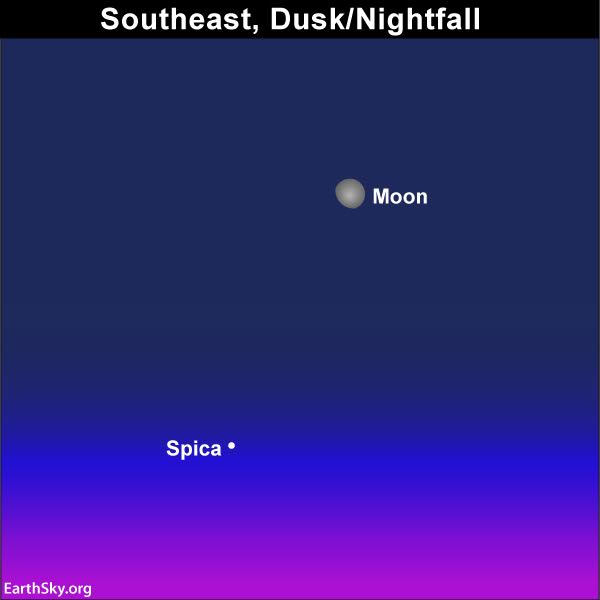
Tonight – April 26, 2018 – the waxing gibbous moon shines to the north of the celestial equator, whereas the the bright star Spica lies to the south of it. The celestial equator is Earth’s equator projected onto the imaginary sphere of stars encircling Earth. At present, the moon resides in the sky’s northern hemisphere. But – in a day or two – the moon will cross the celestial equator to enter the southern half of the starry sky.
The celestial equator isn’t a necessary concept to know for everyday stargazing. You can watch the stars for decades and never give it a thought. But the celestial equator is a useful tool for mapping the sky, in understanding how this imaginary great circle divides the celestial sphere into its northern and southern hemispheres.
____________________________________
This is a perfect night to sample the night sky, checking out Spica and the waxing gibbous Moon. Once you start looking, you'll be hooked! - ilanBeginner's Guide for Rocket, NFPS and IKS66...
http://iptvtalk.net/showthread.php?2...-you-should-do
Kodi Options for Rocket, NFPS and IKS66...
http://iptvtalk.net/forumdisplay.php?71-Kodi
Check the Announcement Section...
http://iptvtalk.net/forumdisplay.php...-Announcements
Similar Threads
-
RCU model pics
By crazed 9.6 in forum BuzzTV RemotesReplies: 25Last Post: 01-05-2024, 10:41 PM -
BuzzTV e1 - pics
By Ryu in forum BuzzTV EssentialsReplies: 0Last Post: 02-01-2021, 01:06 AM -
Zx Pics
By Capt.Kangaroo in forum Formuler ZxReplies: 17Last Post: 09-21-2018, 02:38 PM -
This is cool pics
By Marley in forum Chit Chat LoungeReplies: 0Last Post: 03-06-2018, 06:41 PM -
Space Pics v.3
By Capt.Kangaroo in forum Deep SpaceReplies: 527Last Post: 05-25-2016, 02:09 PM





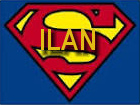

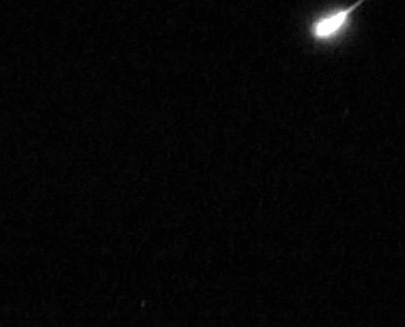

 Reply With Quote
Reply With Quote


